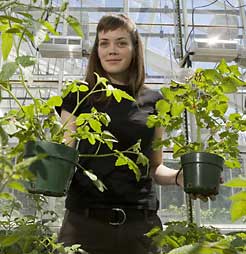Ithaca, New York
July 20, 2007
By Krishna Ramanujan
An arms race is under way in the
plant world. It is an evolutionary battle in which plants are
trying to beef up their defenses against the innovative
strategies of pathogens. The latest example of this war is a
bacterium (Pseudomonas syringae) that infects tomatoes by
injecting a special protein into the plant's cells to undermine
the plant's defense system.
|
 |
|
Robert Barker/University Photography
Tracy Rosebrock, a graduate student in plant pathology
and lead author of a paper appearing in Nature, stands
among wild varieties of tomato plants at the Boyce
Thompson Intstitute on campus. |
"Plant breeders often find that
five or six years after their release, resistant plant varieties
become susceptible because pathogens can evolve very quickly to
overcome plant defenses," said Gregory Martin,
Cornell University
professor of plant pathology, a scientist at the
Boyce Thompson Institute for Plant
Research (BTI) on the Cornell campus and the senior author
of the research paper, published in the July 19 issue of the
journal Nature. "However, every now and then, breeders develop a
plant variety that stays resistant for 20 years or more."
Understanding why some varieties have more durable disease
resistance is important to the development of more sustainable
agricultural practices, he said.
The study by Cornell and BTI scientists describes how a single
bacterial protein, AvrPtoB, which is injected by P. syringae
into plant cells through a kind of molecular syringe, can
overcome the plant's resistance. Normally, the plant's defense
system looks out for such pathogens and, if detected, mounts an
immune response to stave off disease. As part of this
surveillance system, tomatoes carry a protein in their cells
called Fen that helps detect P. syringae and trigger an immune
response.
But some strains of P. syringae have evolved the AvrPtoB protein
that mimics a tomato enzyme known as an E3 ubiquitin ligase,
which tags proteins to be destroyed. Once injected, AvrPtoB
binds the Fen protein, and the plant's own system eliminates it,
allowing the bacteria to avoid detection and cause disease.
"This paper explains how a pathogen can evolve to escape
detection," said lead author Tracy Rosebrock, a graduate student
in Cornell's Department of Plant Pathology and BTI. "The
bacterium has one specific protein that it uses to turn off the
plant's immunity."
The researchers found that the Fen gene is present in both
cultivated tomatoes and many wild tomato species, leading them
to believe that the gene is likely ancient in origin and that
many members of the tomato family have used it to resist P.
syringae infections over the years. Since the Fen protein still
detects AvrPtoB-like proteins from some strains of P. syringae,
prompting an effective immune response, the researchers believe
new P. syringae strains have only recently evolved a version of
AvrPtoB that includes an E3 ubiquitin ligase enzyme that
interferes with the plant's surveillance.
"This paper provides molecular data that supports the
evolutionary 'arms race' theory" that as pathogens develop new
ways to spread and attack organisms, the organisms in turn
create novel defenses, each in a continuous battle to outdo the
other, said Rosebrock.
The research was funded by the National Institutes of Health,
the National Science Foundation and the Triad Foundation, a
private charitable trust.
Other news
from the
Boyce Thompson Institute for Plant Research |
|